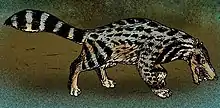Viverra leakeyi
Viverra leakeyi, also known as Leakey's civet[2] or the giant civet,[2] is an extinct species of civet. Its fossils have been found in Africa, from Langebaanweg, Ethiopia, Tanzania, and the Omo Valley.[3][4]
| Viverra leakeyi Temporal range: Late Miocene to Pleistocene | |
|---|---|
 | |
| Scientific classification | |
| Kingdom: | Animalia |
| Phylum: | Chordata |
| Class: | Mammalia |
| Order: | Carnivora |
| Suborder: | Feliformia |
| Family: | Viverridae |
| Genus: | Viverra |
| Species: | †V. leakeyi |
| Binomial name | |
| †Viverra leakeyi Leakey, 1982[1] | |
Description
Being the largest viverrid currently known to ever exist,[3] it grew to about the size of a small leopard, around 40 kilograms (88 lb) and 59 centimetres (23 in) high at the shoulder. V. leakeyi looked physically similar to living Asiatic civet species but is thought to be more closely related to the African Civettictis civetta due to their location.[5][6]
Diet and behavior
This civet's dentition indicates it more than likely was strictly carnivorous, in comparison, living civet species are observed to be omnivorous instead. Because of V. leakeyi's size and dentition, the living animal is thought to be an active predator.[2]
References
- Meave G. Leakey, John Michael Harris (Aug 13, 2013). Lothagam: The Dawn of Humanity in Eastern Africa. Columbia University Press. p. 688. ISBN 9780231507608.
- "Viverra leakeyi". Retrieved 8 March 2014.
- Raffaele. "Remarks on the Messinian carnivores (Mammalia) of Italy." Bollettino della Societa Paleontologica Italiana 47.2 (2008): 196-201. Print.
- Brands, S.J. (comp.) 1989-present. The Taxonomicon. Universal Taxonomic Services, Zwaag, The Netherlands. Accessed March 7th 2014.
- Turner, Alan. National Geographic prehistoric mammals. Washington, D.C.: National Geographic, 2004. Print.
- "†Viverra leakeyi Petter 1963 (civet)". FossilWorks. Retrieved 8 March 2014.